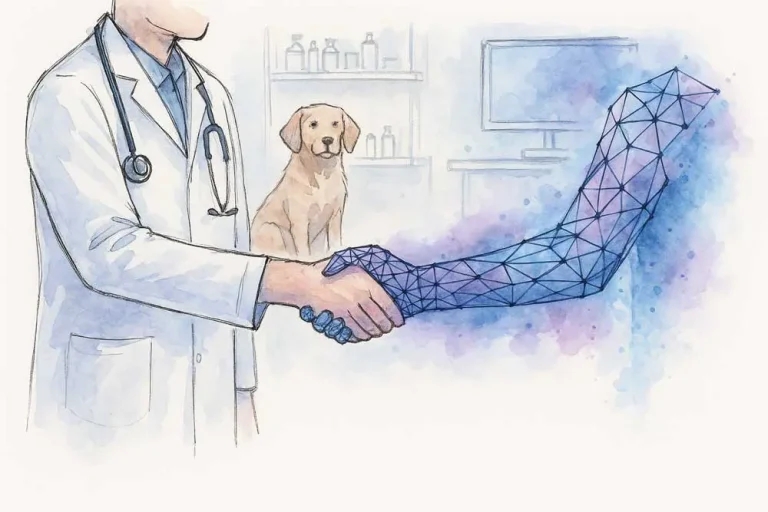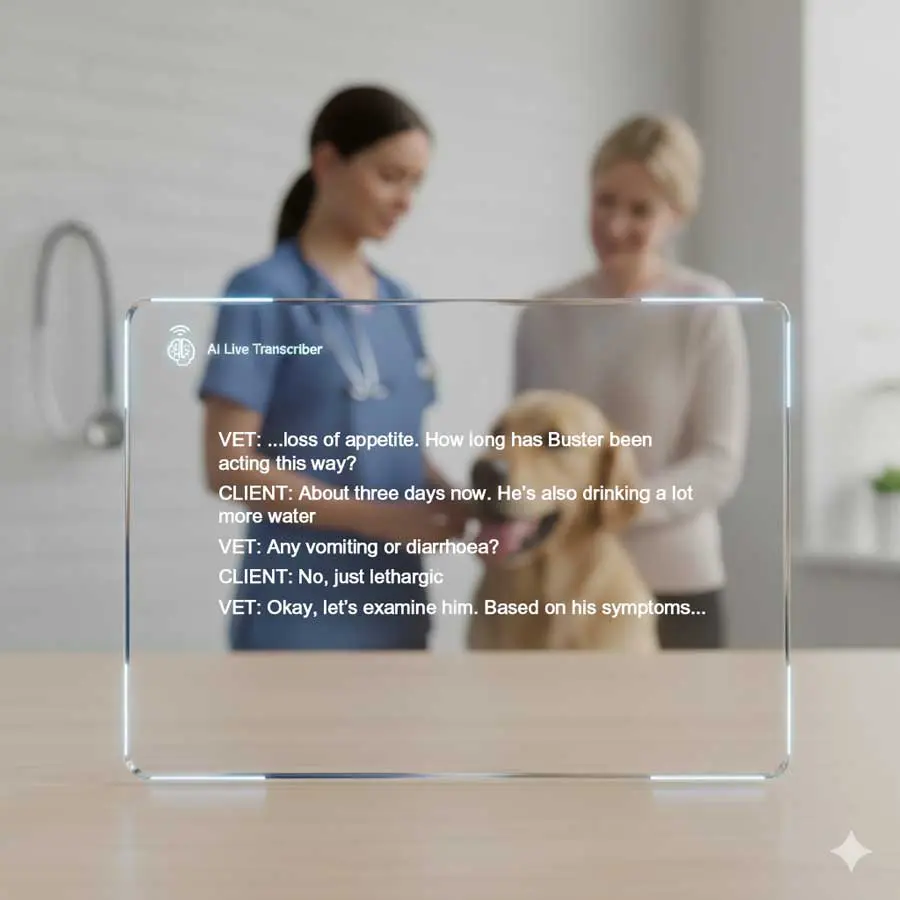15 Nov 2025
While AI and digital tools have transformed human health, many vets remain cautious. However, this shift is not about replacement, but about empowering vets with modern tools, like AI triage and telemedicine, to improve care efficiency…

Image: AI/ Sora
In human health care, AI and digital tools have already transformed the patient experience, yet in veterinary medicine, we’re still at the beginning of our journey.
Understandably, many vets are cautious, with many citing concerns about AI accuracy and many worried about what it means for the future of their roles.
But this isn’t a story about AI replacing vets. It’s about using modern tools – from AI triage to telemedicine – to support the people who dedicate their lives to animal care. Because while technology is exciting, the goal is simply giving vets back their energy and headspace to focus on what matters most – their patients and, critically, those with complex health conditions.
The veterinary profession is facing enormous pressure and it’s leading to high rates of burnout and serious mental health concerns. Day-to-day, many are juggling full schedules and high client expectations, all alongside the emotional toll that tough clinical decisions take.
At the same time, pet ownership is rising and so are costs. For some owners, the financial pressure is so acute that they’re turning to alternatives for pet health, including two per cent (which equates to 370,000 pets) even considering human medicines, to avoid vet bills.
Meanwhile, misinformation online is adding another layer of complexity, often making owners more anxious and sometimes more demanding, and, unfortunately, they’re reading or even acting on inaccurate information.
The mix of overload and scrutiny is leaving vets exhausted and owners confused. That’s where technology can make a tangible difference.
There’s a perception that AI could edge humans out of the process. In reality, the most effective tools do the opposite. They make it easier for vets to do their jobs and for owners to get the right advice at the right time.
Take AI-driven transcription tools, for instance. They can record and summarise consultations automatically, so vets don’t have to. Meanwhile, triage algorithms can help prioritise urgent cases, so clinicians know who to speak to first – or flag up when an in-person visit isn’t needed at all, saving time for vets and a potentially stressful visit for the pet.
Technology can’t solve the emotional toll of caring for sick animals on its own, but it can relieve some of the structural causes of stress. Automating paperwork, reducing appointments and providing decision-support tools all help to lighten the load that’s contributing to vet burnout.
Remote consultation platforms are another key part of this evolution. They allow vets to work flexibly, often from home, improving work-life balance and retention. They also make care more accessible to owners who might otherwise face long waits or costly emergency fees.
Crucially, the human connection doesn’t disappear. The tools simply create space for it to flourish. By removing repetitive tasks and smoothing communication, tech enables vets to spend more meaningful time with patients and owners, which is the reason most of us entered the profession in the first place.

Sometimes, the hardest part of being a pet owner is knowing when to worry. That’s where digital triage and telemedicine step in, guiding people to the right care quickly.
Take Archie, a seven-year-old springer spaniel. One weekend, he was stung, and his face began to swell. His owner was understandably panicked, but was it an emergency? They’d tried Googling how to remove a stinger safely, but the swelling made it impossible. However, thanks to an online consultation with a vet, Archie’s vitals could be checked remotely and his owner was reassured it was safe to monitor him for 48 hours.
In contrast, when Archie broke his elbow (before his owners had access to remote care), they delayed seeking help because they didn’t realise how serious it was. The point of this story is that technology can help avoid unnecessary vet visits yes, but it’s also about knowing when to get help and preventing emergencies with informed decision-making.
This kind of guided access ensures a vet’s time is reserved for cases that truly need it, while owners feel empowered and supported every step of the way.
The most effective technologies are designed with vets, not just for them. Increasingly, vets are involved in reviewing and refining AI systems, helping to assess them for accuracy, safety, reliability and empathy. This process keeps humans firmly in the loop, while helping clinicians build confidence in what technology can (and can’t) do.
Many of these tools also contribute to professional development. Training and validation work with AI systems counts towards continuing professional development (CPD), allowing vets to build new digital and analytical skills alongside their clinical expertise.
Rather than distancing vets from care, this partnership strengthens their role. They remain in control, but with smarter tools at their disposal – just as pilots rely on autopilot or doctors use diagnostic software to enhance precision.
The long-term vision is not only to treat faster, but to prevent illness altogether. Preventive care will become the cornerstone of modern veterinary medicine, supported by tools that empower owners and identify issues earlier.
For example, gait-analysis tools can review a short video of a pet walking and flag potential mobility issues before they become painful or chronic. Similarly, models that analyse skin and gastrointestinal health are being developed to help owners understand when something might warrant further investigation.
This data doesn’t replace the vet, but helps keep everyone more informed. Instead of waiting for crises, we can act sooner and more effectively.
Of course, if we simply encouraged every owner to visit the clinic more often, we’d overwhelm an already overstretched system. The smarter approach is to make vet-validated guidance more accessible.

If we look ahead, the veterinary system could soon resemble the structure of human health care. Think of smart tools and telemedicine as the receptionists and GPs, namely, the first port of call in handling triage and routine issues. Meanwhile, the physical vet clinic becomes the specialist hospital, focused on advanced treatments and complex cases.
Ultimately, the magic lies in collaboration both between people and technology, and between vets and owners. Whether it’s an algorithm helping to prioritise patients, a telemedicine platform supporting pet owners that can’t easily make it to a practice, or an AI note taker letting vets look up from their keyboards, these innovations exist to make care more human, not less.
As we move into this new era of veterinary technology, the one principle that remains constant is that animals don’t need robots – they need people. Technology is just the helping hand that makes sure those people are there when it matters most.
Sam Webster is director of clinical operations at Vet-AI. She graduated from the RVC in 2012 and has extensive experience working as a small animal vet.